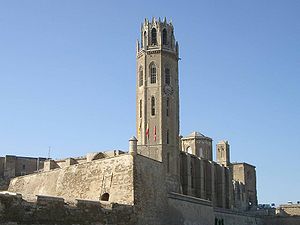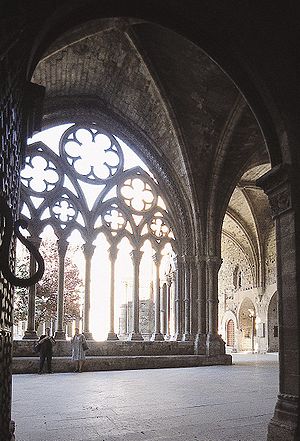
La Seu Vella
Encyclopedia


Cathedral
A cathedral is a Christian church that contains the seat of a bishop...
church of the Roman Catholic Diocese of Lleida, in Lleida
Lleida
Lleida is a city in the west of Catalonia, Spain. It is the capital city of the province of Lleida, as well as the largest city in the province and it had 137,387 inhabitants , including the contiguous municipalities of Raimat and Sucs. The metro area has about 250,000 inhabitants...
, Catalonia
Catalonia
Catalonia is an autonomous community in northeastern Spain, with the official status of a "nationality" of Spain. Catalonia comprises four provinces: Barcelona, Girona, Lleida, and Tarragona. Its capital and largest city is Barcelona. Catalonia covers an area of 32,114 km² and has an...
, Spain
Spain
Spain , officially the Kingdom of Spain languages]] under the European Charter for Regional or Minority Languages. In each of these, Spain's official name is as follows:;;;;;;), is a country and member state of the European Union located in southwestern Europe on the Iberian Peninsula...
, located on top of Lleida hill.
In 1707, the Gothic
Gothic architecture
Gothic architecture is a style of architecture that flourished during the high and late medieval period. It evolved from Romanesque architecture and was succeeded by Renaissance architecture....
cathedral was turned into a military citadel by decision of King Philip V of Spain
Philip V of Spain
Philip V was King of Spain from 15 November 1700 to 15 January 1724, when he abdicated in favor of his son Louis, and from 6 September 1724, when he assumed the throne again upon his son's death, to his death.Before his reign, Philip occupied an exalted place in the royal family of France as a...
. The new cathedral, known as the Seu Nova (New See) and located downhill at Carrer Major, was consecrated in 1781.
Nevertheless, the Seu Vella is the defining monument of Lleida, the symbol of the city, being visible from its hilltop site anywhere in the city.
History
The site was previously home to a Palaeo-Christian and Visigothic cathedral, which later, after the Islamic conquest of Spain, was rebuilt in 832 to be used as a mosque. In 1149, after the city's conquest by the Christian Ramon Berenguer IV of Barcelona and Ermengol VI of UrgellErmengol VI of Urgell
Ermengol VI , called el de Castilla, was the Count of Urgell from 1102 to his death. He was the son and successor of Ermengol V and María Ansúrez.He was born in Valladolid, whence his nickname comes...
(1149), the structure was reconsecrated as "Santa Maria Antiqua", and entrusted to the Augustinians
Augustinians
The term Augustinians, named after Saint Augustine of Hippo , applies to two separate and unrelated types of Catholic religious orders:...
.
In 1193, however, the Lleida cathedral council ordered the construction of a new edifice, following the contemporary Romanesque
Romanesque architecture
Romanesque architecture is an architectural style of Medieval Europe characterised by semi-circular arches. There is no consensus for the beginning date of the Romanesque architecture, with proposals ranging from the 6th to the 10th century. It developed in the 12th century into the Gothic style,...
architectural canons, to master Pere de Coma
Pere de Coma
Pere de Coma was a medieval architect who died in the 13th century, the introducer of Romanesque in the Catalan city of Lleida.His background is nowadays unknown. However, it was been suggested by scholars such as Roca Florejachs that his origins lay in Lombardy, while other scholars hint at...
. The first stone was laid in 1203 by King Peter II of Aragon
Peter II of Aragon
Peter II the Catholic was the King of Aragon and Count of Barcelona from 1196 to 1213.He was the son of Alfonso II of Aragon and Sancha of Castile...
and count Ermengol VII of Urgell
Ermengol VII of Urgell
Ermengol VII was the Count of Urgell from 1154 to his death. He was called el de Valencia.The son of Ermengol VI and his first wife, Arsenda of Cabrera, in 1157, Ermengol VII married Dulce, daughter of Roger III of Foix and Jimena de Osona, who acted as his regent during his absences in Castile...
. Construction continued throughout the reign of James I of Aragon
James I of Aragon
James I the Conqueror was the King of Aragon, Count of Barcelona, and Lord of Montpellier from 1213 to 1276...
. It was consecrated to the Virgin Mary on 31 October 1278. The cloisters were not completed until the 14th century, at which time work on the belltower was begun. It was finished in 1431.
In 1707, the city was conquered by the troops of Philip V
Philip V of Spain
Philip V was King of Spain from 15 November 1700 to 15 January 1724, when he abdicated in favor of his son Louis, and from 6 September 1724, when he assumed the throne again upon his son's death, to his death.Before his reign, Philip occupied an exalted place in the royal family of France as a...
: the king ordered the destruction of the cathedral because it has taken a prominent part in the city's defense. Nevertheless, the order was never executed, and the cathedral was converted into barracks. The building was declared a national monument in 1918, and restoration works were started in 1950.
Description
The cathedral is designed in a transitional style between RomanesqueRomanesque architecture
Romanesque architecture is an architectural style of Medieval Europe characterised by semi-circular arches. There is no consensus for the beginning date of the Romanesque architecture, with proposals ranging from the 6th to the 10th century. It developed in the 12th century into the Gothic style,...
and Gothic
Gothic architecture
Gothic architecture is a style of architecture that flourished during the high and late medieval period. It evolved from Romanesque architecture and was succeeded by Renaissance architecture....
. It lacks almost any influence of Islamic architecture
Islamic architecture
Islamic architecture encompasses a wide range of both secular and religious styles from the foundation of Islam to the present day, influencing the design and construction of buildings and structures in Islamic culture....
. The floor plan is of a basilica
Basilica
The Latin word basilica , was originally used to describe a Roman public building, usually located in the forum of a Roman town. Public basilicas began to appear in Hellenistic cities in the 2nd century BC.The term was also applied to buildings used for religious purposes...
in a Latin cross with a nave
Nave
In Romanesque and Gothic Christian abbey, cathedral basilica and church architecture, the nave is the central approach to the high altar, the main body of the church. "Nave" was probably suggested by the keel shape of its vaulting...
and two aisle
Aisle
An aisle is, in general, a space for walking with rows of seats on both sides or with rows of seats on one side and a wall on the other...
s. The tower is octagonal with a central space of five apse
Apse
In architecture, the apse is a semicircular recess covered with a hemispherical vault or semi-dome...
s. The interior was decorated in painted murals and sculpture, much of which is still preserved, but much of which has been despoiled during the War of Spanish Succession.
The octagonal tower is 12.65 metres (41.5 ft) in diameter at its base, but 9.62 metres (31.6 ft) at the top. Its maximum height is 60 metres (196.9 ft) and it contains 238 steps. A bell named Mònica announces the quarter-hours and one Silvestra announces the hours. The bells are of the international Gothic
International Gothic
International Gothic is a phase of Gothic art which developed in Burgundy, Bohemia, France and northern Italy in the late 14th century and early 15th century...
style of the 15th century.
The cloister
Cloister
A cloister is a rectangular open space surrounded by covered walks or open galleries, with open arcades on the inner side, running along the walls of buildings and forming a quadrangle or garth...
is unusually placed in front of the main entrance of the church, and is notable for both its rare opened gallery with views over the city and for its extraordinary size. In fact, this cloister has been regarded as one of the largest cloisters in Europe. This cloister has 17 ornate Gothic windows, each them different. Among them, we could point out the Muslim window of "the palmtrees" and the central one of the westernmost wing, with a complex decoration witch includes both a King David's Star
Star of David
The Star of David, known in Hebrew as the Shield of David or Magen David is a generally recognized symbol of Jewish identity and Judaism.Its shape is that of a hexagram, the compound of two equilateral triangles...
and a Christian cross
Christian cross
The Christian cross, seen as a representation of the instrument of the crucifixion of Jesus Christ, is the best-known religious symbol of Christianity...
.
Sources
See also
- Cathedrals in SpainCathedrals in SpainThe cathedrals in Spain are the diocesan churches in Spain and an important part of the nation's Historical Heritage due to their great historical, religious, and architectural value. For centuries, the Spanish cities were built around them...

